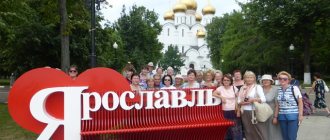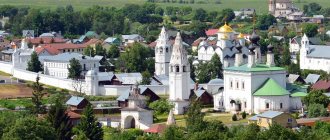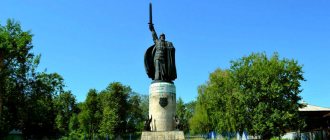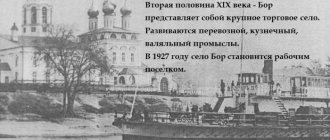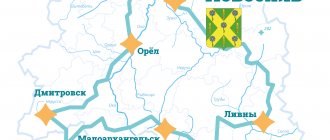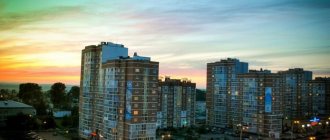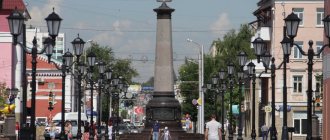> Routes
The Golden Ring is a popular travel route in the Yaroslavl, Vladimir, Kostroma and Ivanovo regions, including the most interesting cities of Central Russia. These are important places from a historical, cultural and architectural point of view, full of sights from different eras. What is included in the large and small ring, what is definitely worth seeing, what and when is the best time to ride?
- Main cities
- Minor
- How to plan a trip
- Map
List of cities
The term itself was coined by journalist and art critic Yuri Bychkov. He included in the route Sergiev Posad, Rostov Veliky, Pereslavl-Zalessky, Yaroslavl, Kostroma, Ivanovo, Vladimir and Suzdal.
- Yaroslavl
- Kostroma
- Vladimir
- Suzdal
- Rostov
- Pereslavl-Zalessky
- Sergiev Posad
- Ivanovo
Yaroslavl
Yaroslavl is considered the capital of the Golden Ring, and this status is by no means nominal. This is the largest and most tourist-rich city on the route. In one day you will only be able to see the center with the main cathedrals, monasteries and panoramic embankments overlooking the Volga. In a few days there will be time to visit interesting places on the outskirts and in the surrounding area.
What you must do in Yaroslavl:
- admire the Yaroslavl architectural style using the example of the Church of Elijah the Prophet ,
- take a walk through the territory of the Spaso-Preobrazhensky Monastery , which was a refuge for the militia of Minin and Pozharsky,
- go down to the Volga on Strelka and Volzhskaya embankment .
Kostroma
The once trade and economic center of the region gradually turned into a calm and cozy Volga city. Kostroma has a rich architectural and cultural heritage, so if you want to visit not only the center, but also the surrounding area, you should budget at least two days.
The central districts are especially interesting for their contrasts: on the territory of the destroyed Kremlin there is a monument to Lenin, and lush classical buildings are adjacent to wooden houses.
During a visit to Kostroma you should:
- walk along the shopping arcades ,
- find all the attractions on Susaninskaya Square ,
- see buildings from different historical eras on Sovetskaya Street .
Vladimir
Despite the fact that Vladimir is actively developing, it manages to preserve its historical atmosphere. Partly due to low-rise buildings and partly due to the good preservation of architectural monuments. Among them are ancient Orthodox churches, wooden residential buildings, noble mansions and unique ancient Russian buildings, such as the impressive Golden Gate.
The main thing about Vladimir is that he has not lost his authenticity. Being a relatively large city where new places are constantly being discovered, it maintains its historical heritage.
In Vladimir you need:
- spend the sunset on the observation deck ,
- see the ancient Dmitrievsky Cathedral , whose facade is decorated with strange fairy-tale creatures,
- admire the frescoes of Andrei Rublev in the Assumption Cathedral,
- pass through Golden Gate .
Suzdal
Suzdal is a small and endlessly cozy city. There are almost no modern buildings here and the historical buildings are well preserved. Among them are more than 53 churches, wooden houses and ancient monasteries.
In Suzdal you must:
- see all the churches on Trade Square ,
- climb the Venerable Bell Tower and try to count all the churches in the area,
- take a walk along the Kamenka River .
Rostov Veliky
Rostov experienced its heyday several centuries ago, and the word “Great” rather refers to the times when it was the center of the large Rostov-Suzdal principality. What remains of its former greatness is the Rostov Kremlin - one of the most beautiful and authentic sights of the entire route. There are not many interesting points outside the Kremlin, so you can come here for half a day.
While in Rostov, you need to:
- visit the Rostov Kremlin and the Metropolitan Garden ,
- go down to Lake Nero ,
- look at the stars on the dome of the Church of the All-Merciful Savior at Torg .
Pereslavl-Zalessky
This small city in the Yaroslavl region occupies an important place in history. It was founded by Yuri Dolgoruky back in the 12th century, who wanted to make it the new capital. Important historical figures are also associated with Pereslavl: Alexander Nevsky was born here, and Peter I began the construction of an amusing flotilla, which laid the foundation for the Russian fleet.
Pereslavl-Zalessky is full of attractions, including ancient monasteries, churches and pre-revolutionary estates.
Here you need:
- go to the Transfiguration Cathedral , where Alexander Nevsky was baptized,
- take a walk along Lake Pleshcheevskoye ,
- walk to the historical district of Rybnaya Sloboda .
Wiki/Commons
Pereslavl-Zalessky is one of those cities that is best visited with a guide, because without a detailed story, ordinary sightseeing may not be very exciting. To do this, you should book a tour with a local guide:
Sergiev Posad
Sergiev Posad is located not far from Moscow, so it can be the first point of the route if you are leaving from the capital. Most tourists come here for the Trinity-Sergius Lavra. The Lavra consists of more than fifty buildings, including outstanding architectural monuments and important religious shrines. There are also several interesting places in the vicinity, for example, the Abramtsevo estate and the Spaso-Vifansky Monastery, but most likely on your first visit there will only be enough time to explore the large-scale monastery complex.
In the Holy Trinity Lavra of Sergius in Sergiev Posad you need:
- go to the Trinity Cathedral , which was painted by Andrei Rublev and where the relics of Sergius of Radonezh are located,
- see the Assumption Cathedral - the tomb of Boris Godunov and his family,
- admire the beautiful temple of St. Zosima and Savvaty of Solovetsky .
Wikipedia/Commons
Ivanovo
Ivanovo is significantly different from other cities, since first of all it is notable not for its ancient churches and monasteries, but for its monuments of constructivism. It was here that the First Council was created and large-scale experiments were carried out to create residential complexes with a common life, according to the ideas of socialism: Collective House, Horseshoe House, Ship House and others.
Not many ancient Russian and pre-revolutionary buildings have survived, but there is also something to see, for example, the Shchudrovsky tent and the Dühringer estate in the Art Nouveau style. Read more in the Ivanovo guide.
In the city there is:
- walk along Lenin Street to see examples of constructivism, and along Pushkin Street to see pre-revolutionary buildings,
- see the famous textile factory on the banks of the Uvodi River,
- visit the oldest building in Ivanovo - the Shchudrovskaya tent .
Sergiev Posad
The Trinity Lavra of St. Sergius is the largest monastery in Russia.
Traditionally, the starting point of the Golden Ring route is Moscow - from the capital you can get to Sergiev Posad
.
The main attraction is, of course, the former secluded monastery of Sergius of Radonezh, which over 700 years has turned into a dazzling Lavra
.
Please note that people are allowed into its territory only in closed clothing with long sleeves; women should take care of skirts and scarves. After visiting the monastery, go to the Kelarsky Pond, and then to the Toy Museum with a touching collection. You can continue to feel nostalgic in ancient quarters surrounded by wooden houses. For those who are not limited in time, we advise you to stop by the Abramtsevo estate
with a shady park,
the village of Vzglyadnevo
with the
Gremyachiy Klyuch
and
the Paraklitovo hermitage
with a peaceful atmosphere that is so rare these days.
What to try:
in the refectory of the Lavra they serve delicious pies, gingerbread, kvass, fireweed tea and honey at reasonable prices.
What to bring:
religious paraphernalia, birch bark products, down scarves, Bogorodsk bears.
Unofficial cities
The original route was later expanded with additional cities. All of them have a rich history, a wide cultural heritage and are worthy of attention.
- Uglich
- Rybinsk
- Gus-Khrustalny
- Moore
- Myshkin
- Plyos
- Yuriev-Polsky
Uglich
An ancient Volga city, where almost every church has an interesting and complex history. Read more about all the sights of Uglich. Also here you can see the hydroelectric power station, for the creation of which Mologa and Kalyazin were flooded. In general, this is a very pleasant place with beautiful views of the Volga and ancient architectural monuments.
In Uglich you need:
- go to the Kremlin , where the church is located at the site of the murder of Tsarevich Dmitry,
- walk along the embankment from the Church of Flora and Lavra to the Uglich hydroelectric station ,
- admire the Epiphany Monastery , built according to the design of K.A. Ton.
Rybinsk
Rybinsk is different from other places on this list. It is notable for its ancient churches, but rather for its mansions and 19th-century heritage. It was once a trading center, and from those times the beautiful building of the Corn Exchange remained, which is now occupied by a museum. If you have time, you can go to the Rybinsk Reservoir, which is sometimes called the sea.
In Rybinsk there is:
- visit the antique-style Red Square ,
- walk from Rybinsk Bridge to the beach,
- take a walk along the main Krestovaya Street .
Gus-Khrustalny
Gus-Khrustalny is known primarily for the crystal industry, to which it owes its unusual name. There are many points associated with crystal: a crystal museum, a special market and a crystal factory, where tours are conducted.
Historical attractions include the 19th-century Holy Trinity Cathedral and Russian-style brick buildings.
In Gus-Khrustalny it is worth visiting:
- the richly decorated St. George's Cathedral ,
- the best buildings in the Russian style: the former men's school , the historical museum and the Maltsov houses ,
- Chapel of the Holy Great Martyr Barbara.
Flickr/alexxx-malev
Moore
Murom was mentioned in the Tale of Bygone Years, which makes it one of the oldest Russian cities. From ancient times, the main Murom monument, the Holy Transfiguration Monastery, has survived to this day. Pre-revolutionary buildings in the center have also been well preserved.
It is convenient to start your tour from here if you are coming from Nizhny Novgorod, since it is located on the border with the Nizhny Novgorod region.
3 things to do in Murom:
- visit the Holy Transfiguration Monastery , founded by the son of Prince Vladimir,
- go to the Holy Trinity Cathedral , where the tomb with the relics of Peter and Fevronia is kept,
- take a walk along the Oka River .
Wiki/Commons
Myshkin
Surprisingly, Myshkin actually got its name in honor of the mouse that once saved the prince from a snake bite. Myshkin was never big, and there were no industrial enterprises on its territory. Nevertheless, in the 19th century it was an exemplary merchant town, and since then it has preserved ancient buildings, mansions and museums.
Since the 1980s, it was decided to develop the tourist potential of Myshkin and come up with its own distinctive feature that would attract travelers. Several museums dedicated to mice, a mouse palace and several mouse monuments appeared. Many restaurants and hotels also play on this theme in their names, for example, the MyshkINN hotel or the Mousetrap cafe, making it the most unusual city of the Golden Ring.
Here you need to see:
- the rather impressive Mouse Palace ,
- Assumption Cathedral of the 19th century,
- study the history of Russian merchants,
- Volga embankment , going to the left from the river station.
Plyos
Plyos is best known for the fact that its landscapes were painted by Levitan. The artist painted more than 200 canvases in Plyos and its environs. Surprisingly, the city has not changed much since then - it is still a quiet and picturesque place with wooden houses, churches and art museums. Along with Kostroma, Plyos became the location for the filming of the film “Cruel Romance.”
In Plyos there is:
- visit Sobolinaya Mountain ,
- see the Church of the Resurrection , depicted in Levitan’s paintings.
Wikipedia/Commons
Yuriev-Polsky
Yuriev-Polsky was also founded by Yuri Dolgoruky. It is notable primarily for its St. George Cathedral - one of the rare and most beautiful examples of pre-Mongol architecture. But the Archangel Michael Monastery was destroyed during the Tatar-Mongol invasion, but rebuilt several centuries later.
In Yuryev-Polsky there is:
- imagine what pre-Mongol Russian architecture was like using the example of St. George's Cathedral ,
- enter the ranks of Gostiny Dvor ,
- climb the bell tower of the main monastery .
Wiki/Commons
Ivanovo
Ivanovo is a relatively young, cozy city of the Golden Ring of Russia, endowed with a large number of attractions and architectural monuments.
The first mention of Ivanov dates back to 1561 and is associated with the name of Ivan the Terrible. Compared to other cities of the Golden Ring, there are much fewer historical attractions here. Start your route from the Cathedral of the Assumption of the Blessed Virgin Mary . The shrine was built in 1834.
The Kazan Church is located on the banks of the Uvodi. In its place there was once a calico-printing factory. The object, as conceived by the architect Maricelli, was distinguished by its laconic beauty and grandeur.
It is worth seeing the Transfiguration Cathedral, the Temple of Elijah the Prophet, the Temple of the Icon of the Mother of God.
Hotels in Ivanovo.
What to go on?
The best time to travel is late spring and early autumn. The May holidays and September, when golden autumn arrives, are perfect. Summer is best if you are traveling on a cruise along the Volga.
Automobile
Of course, the most convenient way to travel along the Golden Ring is by car. First of all, this is mobility, which will allow you to visit small towns and remote but interesting points along the way.
A significant disadvantage of car travel is the need to prepare yourself. And since almost all points are full of attractions with a rich history, preparations can take a long time.
Cruise
The most comfortable and picturesque way would be a cruise along the Volga. It allows you to see all the cities on the Volga, including Yaroslavl, Kostroma, Uglich and others. An undoubted advantage is the opportunity to look at panoramas from the water and see river landscapes that are inaccessible to other modes of transport.
It’s also convenient that you don’t need to think about accommodation and excursions: the cruise provides all this. By the way, it can also be used as a method of transportation, for example, many ships start from Moscow or Yaroslavl. Or you can travel part of the way by water, then get off at any station and continue the journey by land. For example, from Yaroslavl to Kostroma, Myshkin or Rybinsk. Or from Kostroma to Rybinsk, Myshkin and Moscow.
You can conveniently select the most profitable and optimal options here.
Buses
If you want to travel the entire route on a budget, but you don’t have a car, this is not a reason to postpone your plans. Trains and buses run through all points of the route. However, visiting all points on public transport at once will be problematic. The most convenient way would be to take a train to Yaroslavl or Vladimir and start the journey from there by bus.
The bus service is quite well developed, although the bus stations and the buses themselves are not always very comfortable. But ticket prices average 150-300 rubles.
Housing
The best hotels where you can stay when traveling along this route: Hostel in Uglich, Royal Hotel Spa & Wellness in Yaroslavl, Inspiration of Levitan in Plyos, Hostel “Sova” in Ivanovo.
The most profitable accommodation option if you are traveling alone or in a group will be apartments - usually there are much more of them than hostels and hotels.
Why is the Golden Ring of Russia called that?
A tourist route with this name appeared in the 60s of the last century thanks to art critic and artist Yuri Bychkov. His material about his travels through the ancient cities of Russia was published on the pages of Soviet Culture. During the preparation of a series of essays, he independently developed a circular route from Moscow, which can be overcome without problems in 1 day. Well, the word “Golden” appeared in the name thanks to the gilded domes of churches and cathedrals, which are the main attractions of ancient cities that were once part of Vladimir Rus'.
Kasimov
Kasimov - a symbiosis of the heritage of two cultures at once
The capital of the Qasim Khanate entered the route of the Golden Ring quite recently, but has already managed to fall in love with tourists for its original merchant houses, Cathedral Square
,
the Ascension Cathedral
and
the Museum of Local Lore
with collections of artistic castings, costumes of the Kasimov Tatars, polychrome sculpture and Vyrkov toys.
The Khan Mosque
and
the mausoleum of the Afghan-Muhammad Sultan
remind us of Muslim rulers .
What to try:
solyanka, okroshka, stew and rabbit cutlets, chak-chak, belyashi, lula kebab.
What to bring:
pickles, skullcaps, sweets from the local confectionery factory “Fidelity to Quality”.
Suzdal
Suzdal - a city of holidays on a merchant scale.
Hospitable Suzdal
– a unique open-air museum, an island of Ancient Rus'.
The white-stone Kremlin
with buildings of the pre-Mongol period, several monasteries,
the Museum of Wooden Architecture
with perfectly preserved barns, houses, mills and temples - all this delights, surprises and penetrates the heart.
Look for souvenirs in the shopping arcades, take a walk to the impressive Spaso-Evfimiev Monastery
with an observation deck. Suzdal is also known for the scope of its folk festivals, and the reason for the fun may not be related to public holidays. Round dances, riding on a “troika” and down the mountain, a soulful meal with a whole folklore performance - in this city you want, if not to stay, then to return several times!
What to try:
rye flour pies, kulebyaki, stuffed sterlet, royal pike, suckling pig, game - elk, wild boar, pheasant, quail.
What to bring:
the famous Suzdal mead of various types, felt boots, kokoshniks, clay toys.
Kostroma
Who wouldn't want to visit the Snow Maiden herself?
Kostroma
- a fabulous time machine that will take you back to the reign of the House of Romanov.
Ipatiev Monastery
, where Mikhail Romanov was elected, is a must-see on the cultural program.
All the ancient buildings deserve attention: magnificent cathedrals, shrines, royal chambers, and gates in the Baroque style. Other temples in Kostroma are also notable: the Church of the Resurrection
on Debra with many domes,
Elijah the Prophet
on the Settlement on the site of a former temple,
the Savior Not Made by Hands
in the center of the shopping arcade, the Old Believer
Transfiguration of the Lord
.
Museums offer to see unique collections of historical documents, religious exhibits ( Historical and Archival Museum
on the territory of the Ipatiev Monastery);
weapons, medals, orders, banners ( Military History Museum
);
objects of noble life ( "Noble Collection"
);
creations made from traditional materials ( museum of flax and birch bark
).
You can have an unusual time on the excursion “In the footsteps of Ivan Susanin”
, the
“Forest Magician”
and at
the elk farm
.
And you can continue your immersion in the fairy tale by visiting the Snow Maiden
- the granddaughter of Father Frost has been allocated an interactive museum, a tower and a personal residence, where every day is New Year's.
What to try:
fish dishes, cabbage soup, porridge, jam, mead.
What to bring:
Snow Maiden under the Christmas tree, birch bark products, Peter's clay toy, cheese, clothes and accessories made of linen.
Rostov Veliky
The domes of Rostov the Great are famous throughout the country!
And we continue on our way. Next up is Rostov the Great
.
The arched passages of the Kremlin
“Ivan Vasilyevich Changes Profession”
was filmed on its territory .
The hero Alyosha Popovich lived
in the Sarskoe settlement Museum of the Frog Princess
, and in
the Rostov Enamel Museum
you can see masterpieces of local masters.
Borisoglebsky
,
Spaso-Yakovlevsky
and
Epiphany monasteries
are of interest not only to pilgrims: every guest of Rostov should walk along the ancient walls, absorbing centuries-old power with their eyes and soul.
And after a walk along the shores of Lake Nero,
a beastly appetite develops: the city knows about this feature, so most restaurants and cafes offer eternally hungry tourists a rich selection of traditional Russian cuisine.
What to try:
Rostov fish soup from pike perch, teloe, mushroom dishes, fruit drink, mead.
What to bring:
Rostov enamel, black-polished ceramics, gingerbread.
What must be done?
In addition to studying history and visiting iconic places, be sure to:
- Try delicious mead in Suzdal.
- Collect sacred water from a source in Sergiev Posad.
- Make a wish on the blue stone in Pereslavl-Zalessky (they say it will certainly come true).
- Catch a fish in Rostov the Great and say in a whisper: “According to my desire...” (then comes desire).
- Buy famous designer felt boots in Ivanovo.
The list can be continued for a long time, each city has something of its own.

